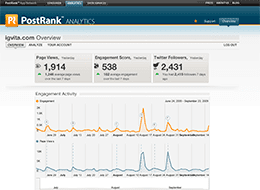
With all the hype over social media during the past several years, e-mail has taken a backseat role in many ways.
That’s a shame. E-mail remains a very powerful marketing tool when used correctly. It can serve as the cornerstone of permission-based relationship marketing — the concept Seth Godin explained in his 1999 book Permission Marketing.
E-mail usually has a higher psychological value than other social media communication. If you are consistently delivering value in your messages people will listen to what you have to say. They may even take action.
This may sound like just theory, but in this article I will show you concrete examples of how hotels are using e-mail marketing to make money. We will look at ways your hotel can use email, how to build your list and create a campaign, benchmarks for testing, and finally some case studies of other hotels.
Part 1: Ways your hotel could use email
Use it as a direct response tool. When done correctly, e-mail allows you to communicate with laser-like focus to specific groups of people. This is one of the best ways your hotel can drive direct bookings.
Use it as an automated sales force. More than any other marketing tactic, email lends itself well to automation. You can create a powerful sales system, and then sit back and let it do the work for you. (At the end of this article, there is a case study of how the Broadmoor Hotel in Colorado used this tactic to generate $245,000 in revenue from a $15,000 investment.)
Use it as a feedback and research tool. Many hotels send an automatic survey link to gather guest feedback. That’s a good start. But I think there are also other ways you can use e-mail to get feedback… not only on the guests stay, but also for new ideas and other market research. This depends on the type of list that you have developed, but the potential is there. Be creative about it.
Use it as a relationship building tool. You can send loyal guests special offers. You can notify them of new amenities or features. You can provide insider information. You can use email to give your organization some personality. The opportunities are endless for building top of mind awareness.
Use it to provide superior guest service. There is so much potential for hotels to use e-mail to improve their guests’ experience. A series of e-mails could be triggered whenever someone makes a reservation: leading up to the stay, and then following up after they leave. Putting everything on autopilot insures every guest has an excellent experience interacting with your hotel. It reduces staff busywork and the potential for errors.

Use email to communicate with other important stakeholders. Email communications don’t always have to be sent to guests. There are other groups you should focus an equal amount of time on.
Fairmont Hotels understands this. Nearly half of their email newsletters are written for and sent to other businesses. One newsletter goes to administrative assistants that handle corporate bookings. Another goes to travel agents. Reaching and working with these people plays a large role in generating revenue.
Thought: What business partners should you be communicating with?
Part 2: Plan your list building strategy
Even aside from the ethical considerations, getting the best results from your email promotional efforts requires you create a list organically and with the explicit permission of your prospects.
- You can include a signup form on your website. Just keep it short: email & first name is best.
- Your front desk staff can ask for addresses during check-in or check out
- You can leave a letter of invitation in their room
However you plan to collect email addresses, make sure there is a strong benefit for the person signing up.
The prospect of receiving generic updates from your hotel may or may not be enough. Exclusive discounts or preferred service is more compelling.
Part 3: How to create an e-mail marketing campaign for your hotel
Tips for putting together good emails for your hotel
- Make sure you get through the spam filters. Mail that isn’t delivered isn’t read.
- Write effective subject lines. Tell what’s inside, but don’t over do it. Sometimes boring is best. Don’t use too much hype.
- Always send a text version of each message. If you’re using HTML, you want to provide an option for people who don’t – or can’t – read that format.
- Use a table of contents for longer emails
- Make the email content scannable
- Include descriptive links with a call to action
- Link to a web version (if the email does not display properly)
- Include a “forward to a friend” link on all messages
Choose a publishing frequency
Whether you plan to publish a monthly newsletter or special offers as they’re available, it’s best to create a schedule and stick to it.
Publishing too often can lead to people unsubscribing. If you don’t publish enough, people may forget about you. Find a frequency that works well with your audience. Better yet, give them the option to choose.

The Deer Valley Ski Resort in Utah publishes a “daily conditions” email. Daily emails may normally be too much, but it works when you’re providing information people want. It certainly made Chip House happy.
Part 4: Test, Test, Test
As with most online marketing, success is achieved through continual testing…and making changes based on what you learn.
Tests usually take the form of split-testing: where you send two variations of an email at the same time to the same list. Most email services make this very easy.
Ideas for testing
- Days of the week (Tuesday…or Saturday?)
- Time of day (morning, afternoon, etc)
- Frequency
- Personalization
- Subjects & Topics
- Content
- Copy
- Graphics
- Colors
- HTML vs. plain text
- Length
- Number of links
- Prices
- Call to action
3 most important email marketing metrics to watch
- Open rates
- Click through rate
- Conversion rate – how many people take the next step…whatever you want that to be
Email marketing benchmarks for hotels
MailChimp, a great little company that I use for most of my email promotions, released a benchmarks report with these figures for the hotel industry:
- Open rate: 27.5%
- Click rate: 7.17%
- Abuse complaints: 0.08%
- Unsubscription rate: 0.49%
As they said, this is slightly biased towards smaller hotels - but it’s close to the averages I’ve seen.
Of course, stats like these only serve as a point of reference — your individual situation may be very different. E-mail campaigns that I’ve run typically perform at least 50-75% better than the numbers above. List quality has a huge impact on your metrics. Keep testing, and you can reach above average levels of performance.
Part 5: A few examples of how hotels are using email
Kimpton Hotels uses affinity-based email to boost revenue
As this case study from MarketingProfs (membership required) shows, creating your email program around individual preferences can dramatically increase profits.
Kimpton had a loyalty program that recognized and accommodated individual perferences of guests: all the way down to the type of pillow they preferred. Steve Pinetti, VP of Sales and Marketing, decided that if their email campaign matched the customer care as well as their loyalty program, they could increase revenue.
To do this, the company created seven affinity groups: wine, pets, dining, eco issues, LGBT, “hot dates and great rates,” and “packages and promotions.” By integrating their databases, guest information was updated in real time. Once this system was set up, Kimpton could send very customized emails based on individual preferences.
The end result? Average revenue generated by a customer email campaign increased from $70,000-80,000 to $350,000-750,000.
Lesson: Identify affinity groups, and plan ways to serve them
The Broadmoor Hotel gathers trade show leads with a savvy followup system
As Karen explains in a ClickZ article, The Broadmoor Hotel was trying to obtain sales leads at a trade show a few years ago. People visiting the Hotel’s booth had their badges swiped, which populated a database. Then, a series of 3 email messages was sent to each prospect:
- Instant followup with an incentive. The recipient was notified of an upcoming drawing for a digital camera. At the same time, the Broadmoor’s benefits to meeting planners were reviewed.
- Are you a winner? A week later, an email was sent asking the person to click through and see if they won the drawing.
- Another contest. Three weeks after the show, prospects received another invitation to enter a contest for a 4-day vacation at the Broadmoor.
The end result? The campaign cost $15,000 and generated $245,000 in revenue.
Lesson: Automate emails to create a powerful sales followup system
The Monmouth Plantation uses “sensory overload” to avoid price cutting & increase response
Recently, I shared the story of Monmouth Plantation, a historic luxury Mississippi inn. Because of the recent economic crisis, the hotel had been using special (low) room rates in their email newsletters to generate business.
Recently, however, they decided to focus on selling their lavish experience – and less on the price. They began sending email promoting sensory-overloading experiences.
For example, read the description of their $1,900 Gourmet Package offer that included two nights of accommodations, a tour of three historic mansions, a carriage ride through the quaint downtown area, and in-room massages:
“Upon arrival, guests will be greeted and escorted to their rooms where chilled champagne, chocolates and flowers await their arrival. That evening guests gather in the dining room for hors d’oeuvres and wine; a host/hostess will give a history of the antebellum home. Dining under 17th century chandeliers on the Empire table with beautiful china, silver and first-class service is the highlight of this package. The chef will greet each guest and invite culinary conversation. After-dinner drinks featuring the Southern signature drink, mint julep, will be served in the study nightly. A private hot air balloon ride over Natchez is the featured activity in this package.”
The result? The email open rate increased 15% and their promotions enjoyed a 30-40% click-through increase.
Lesson: Use “sensory overload” to sell your hotel’s experience in your email promotions

Without a doubt, email is one of the most powerful marketing tools we have at our disposal today.
Please, Please, Please (my closing plea)
Speaking as both a marketing professional and a frequent hotel guest, I just ask you to remember what most of us are thinking:
I’m busy. I don’t have much time. My inbox is my sacred space. I use it to interact with friends, family, and business associates…and I’m not particularly anxious to hear from an organization I barely know that wants to sell me something.
- What’s in it for me? I don’t really care about your business operations. I do want to know about stuff that will help me.
- Ask my permission, and have me confirm before you add me to any list.
- Don’t e-mail me constantly. I probably don’t want to hear from you every single day.
- If you send me something I don’t want, I’ll consider it spam… even if I opted in to your list a long time ago.
- Make it easy for me to leave. If I like your content, I’ll stay.
by
Josiah Mackenzie on
September 11, 2009

